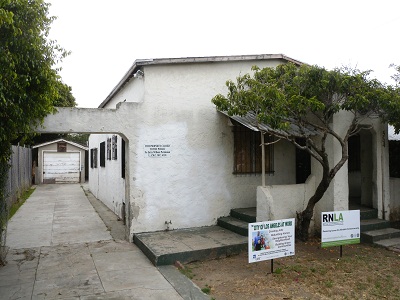
IN THIS ISSUE:
Funding and Incentivizing Energy-Efficient Building Retrofits
Turning Blighted Properties into Pocket Parks:
Los Angeles Case Study
Fireclay Village: A Model for Sustainable Growth
Grantee Spotlight: Plan East Tennessee
Turning Blighted Properties into Pocket Parks: Los Angeles Case Study

Planned park site in South Los Angeles, California. Image courtesy of City of Los Angeles. The federally funded Neighborhood Stabilization Program (NSP), part of HUD’s Community Development Block Grant program, was designed in 2008 to address foreclosures and the blight exacerbated by abandoned properties on neighborhoods. In Los Angeles, for example, where more than 62,000 housing units in the city have entered foreclosure, the city has received some $142.7 million in NSP funds. “We tended to buy the worst properties with the NSP program,” says Douglas Swoger, director of homeownership and preservation for the Los Angeles Housing Department (LAHD), because “we thought we could have the most impact by buying the worst” structures.
Cities have used NSP funds to buy and rehabilitate foreclosed homes and multifamily properties, which are then sold as affordable housing. But NSP also allows housing departments to redevelop these properties for use as public facilities. Beginning in November 2011, LAHD and the city’s Department of Recreation teamed up to repurpose a handful of foreclosed properties as small parks. Rather than refurbishing the foreclosed homes, the city will raze the buildings on nine parcels and develop the sites into pocket parks that range from 4,000 to 8,000-square feet each, for a total of 1.2 acres of green space.
City and Community Collaboration to Increase Park Access
The idea for the pocket park program arose out of an initiative launched by Mayor Antonio Villaraigosa, who in November 2011 announced a plan to increase the City’s green space by developing 50 new parks and open spaces. Adding the parks, according to Mayor Villaraigosa, is one way of making the Los Angeles more livable. The idea of using foreclosed properties as part of this program came later, says Swoger.
To begin, LAHD offered the Department of Recreation the opportunity to tour sites purchased through NSP whose properties “were in such poor condition, it made more economic sense to tear down and build new houses,” says Swoger. They focused on a list of sites in areas that the Department of Recreation had already identified as lacking park space. The Department of Recreation ultimately narrowed this list down to about 20 sites and then hosted public meetings to gauge public opinion about the proposed locations.
At this point, some communities opposed the idea of a park, expressing concern about the potential of open space to attract crime. Swoger says that the Departments will not place a park on any site where the community has expressed opposition. And as president of the USC Lusk Center for Real Estate Richard Green told the Los Angeles Daily News, transforming a foreclosed home into green space — an amenity — has the added bonus of lifting property values for the whole neighborhood.
Ultimately there was community support for nine sites total: eight in South Los Angeles and one in the San Fernando Valley. In these areas, LAHD and the Department of Recreation will ask local residents for input on their desired park amenities (such as exercise equipment, playgrounds, and benches),so they can be designed in response to each community’s needs. At the same time, says Swoger, the parks are planned to be inexpensive to maintain. For instance, he says, they will likely make use of solar lighting and drought-tolerant landscaping.
Currently, the nine pocket park sites are undergoing an environmental review. Once LAHD obtains environmental clearance, it will prepare the sites for park development. Funding for park construction will come from the Department of Recreation, grants, and from a $1.6 million fund for park development from the state of California, which the two departments worked together to obtain.
